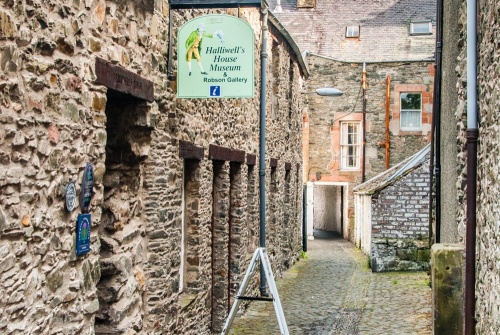
Selkirk is one of the oldest royal burghs in Scotland, with a history dating back to before the 12th century. The town name is a combination of old Scots words meaning 'the church in the forest'. The forest, in this case, is Ettrick Forest, used as a royal hunting ground by Scottish kings. The town grew up on a rise above the twin valleys of the Ettrick and the Yarrow.
In 1113 David, Earl of Cumbria established a Benedictine abbey at Selkirk, populated with monks from Tiron in Picardy. Selkirk Abbey was only in existence for 15 years, for in 1128 the abbey was moved to Kelso.
Around the same time as the abbey was established a motte and bailey castle was built on a natural mound south of the town centre. It was captured and recaptured several times by English and Scots in turn before being destroyed in the buildup to the Battle of Bannockburn in 1314. You can see the limited earthwork remains of Selkirk Castle from a public footpath near the Auld Kirk.
Selkirk became the centre of national attention in William Wallace's struggle to win independence from England in the late 13th century. Wallace knew Ettrick Forest well and it was here in Selkirk that he was declared Guardian of the Kingdom of Scotland in 1297 after his victory at the Battle of Stirling Bridge.
The ceremony took place in the 'Kirk o' the Forest' in Selkirk. The site was recently uncovered by archaeologists in the grounds of the town's ruined 18th century Auld Kirk.
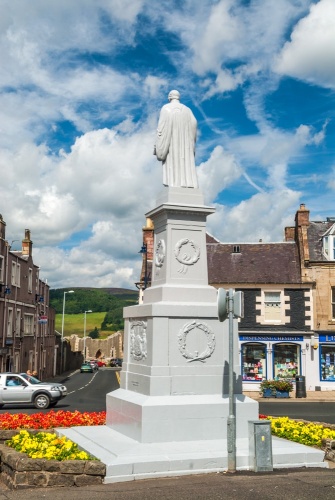
The Flodden Disaster
Selkirk answered James IV call to arms in his conflict with Henry VIII in 1513. The borough sent 80 soldiers with James to the Battle of Flodden. Only one man returned, bearing a blood-soaked English flag, whereupon he collapsed and died. The 'Flodden Flag' can be seen in Halliwell's Museum (see below).
James V, on hearing of the great loss of life, granted Selkirk 10,000 acres of the royal forest of Ettrick. He later gave Selkirk the right to elect a Provost, who held his office directly from the king. This independent government was emphasised still further when James made Selkirk exempt from the authority of the Sherif of Selkirkshire and gave them permission to fortify the town.
Selkirk became a centre of a thriving spinning and weaving industry as early as the medieval period and the Industrial Revolution brought large tweed mills to the town. But it is for its heritage as a centre for making shoes that Selkirk is best remembered.
Natives of Selkirk are known as 'Souters', another term for a cobbler. That town's heritage is remembered in a popular song that ends with the line, 'There's gallant Souters in Selkirk, as long as there's water in Tweed'.
In 1645 Royalists under the Marquis of Montrose did battle with a Covenanter army led by Sir David Leslie at Philiphaugh, two miles outside Selkirk. Montrose and many of his men stayed in Selkirk before the battle, which was a resounding victory for Leslie's men. The most likely site of the battle is where the cricket and rugby clubs now stand.
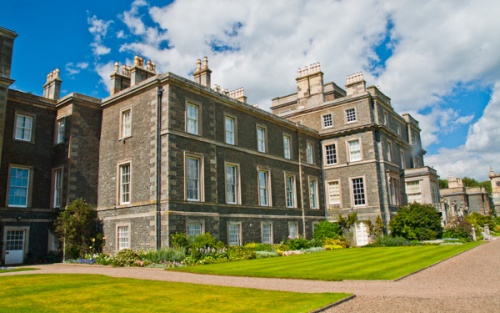
Bowhill House
Just four miles from Selkirk is Bowhill, one of Scotland's great stately homes. Bowhill was built for John Murray, Lord Bowhill in 1708 but the estate dates back to the 12th century.
Within the mansion is the Buccleuch Collection, perhaps the finest art collection in any private house in Scotland. The collection includes porcelain, silver, fine furniture and paintings, as well as items associated with Queen Victoria and Sir Walter Scott. Bowhill House is set in superb landscaped grounds, with attractive woodland walks.
Halliwell's House Museum
Discover the history of the royal burgh of Selkirk in this fascinating museum, housed in a former ironmonger's shop in one of Selkirk's oldest streets. The building dates 'only' to the 18th-century but it stands in a picturesque close of buildings going back 400 years. Halliwell's Museum not only traces the history of Selkirk but the personal stories of people who lived in the close over the centuries.
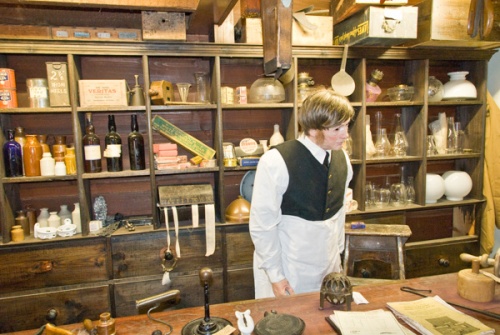
Sir Walter Scott's Courtroom
Sir Walter Scott was not only a famous author; he also served as Sheriff of Selkirkshire for almost 30 years. In that role, he heard cases in the courthouse on Selkirk's picturesque market square. The courtroom where Scott heard cases is now preserved as Sir Walter Scott's Courtroom.
The courtroom has been preserved as it was when Scott practised law here. Learn about Scott's strong links to the Royal Burgh and see personal items. The Courtroom is set up to recreate actual cases heard by Scott. It is a fascinating glimpse into the author's life and times.
In front of the Courtroom stands a striking statue of Scott.
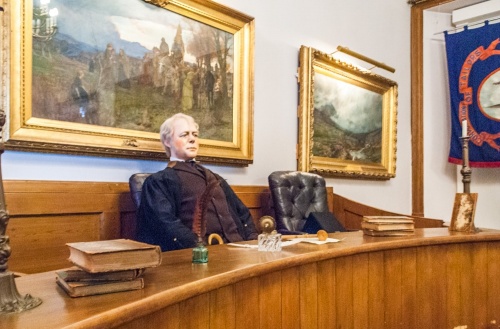
Philiphaugh Salmon Viewing Centre
Just outside Selkirk is this popular visitor attraction where you can see salmon making their way upriver to their spawning grounds. The best times of the year to view the salmon are May-June or September-November, especially when the river is high. The viewing centre also features a lovely restored walled garden. You can also get leaflets outlining a walk around the Philiphaugh battlefield.
Our family really enjoyed our all-too-brief visit to Selkirk and can't wait to return. The area is incredibly beautiful and there is history around every corner.
About Selkirk
Address: Selkirk,
Borders,
Scotland
Attraction Type: Town
Location: On the A7 roughly seven miles south of Galashiels
Website: Selkirk
Location map
OS: NT469286
Photo Credit: David Ross and Britain Express
POPULAR POSTS
HERITAGE
 We've 'tagged' this attraction information to help you find related historic attractions and learn more about major time periods mentioned.
We've 'tagged' this attraction information to help you find related historic attractions and learn more about major time periods mentioned.
Find other attractions tagged with:
NEARBY HISTORIC ATTRACTIONS
Heritage Rated from 1- 5 (low to exceptional) on historic interest
Halliwell's House Museum - 0.1 miles (Museum) ![]()
Bowhill - 2.6 miles (Historic House) ![]()
Abbotsford House - 4.2 miles (Historic House) ![]()
Eildon Hills - 5.3 miles (Countryside) ![]()
Harmony Garden - 5.9 miles (Garden) ![]()
Priorwood Garden - 5.9 miles (Garden) ![]()
Melrose Abbey - 5.9 miles (Abbey) ![]()
Glebe Stone - 7.3 miles (Prehistoric Site) ![]()



